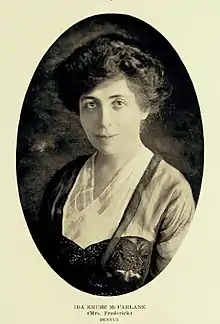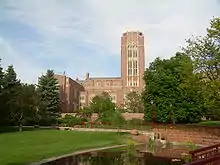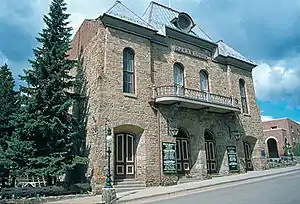Ida Kruse McFarlane
Ida Kruse McFarlane (1872-1940) was an English professor and head of the English department at the University of Denver. In 1931, she negotiated to have the Central City Opera House donated to the university.

Early life and education
Ida Kruse was born in Central City - Black Hawk area in 1872.[1][2][lower-alpha 1] Her parents were Frederick and Letta Kruse. She had a sister, Clara, and a brother named Frederick.[4] Her father was the major of Central City,[5] where she grew up and attended a convent school, St. Aloysius.[3][6]
McFarlane received her Bachelor of Arts and Masters of Arts degrees from Vassar College[7] and studied in Europe at various universities. She received an honorary Doctorate of Literature from the University of Denver in 1914.[3]
Career
She began her work career as Ida Kruse[8][9] and around 1907 she married Frederick McFarlane,[10][9] a mining manufacturer who was born and educated in Central City.[11] Between 1903 and 1907, McFarlane was Superintendent of schools for Gilpin County, Colorado.[8][10][12]

She taught English during the 1905-1906 summer interim at the University of Denver and formally joined the university's English faculty in 1907. She taught English literature[9] and served as head of the English Department until her death in 1940. She taught modern poetry, drama, the French language, Spanish literature, and phonetics.[3] She was particularly interested in the works of Ezra Pound, Carl Sandburg, and T. S. Eliot. She offered and taught courses in manners and, with a colleague, created seven courses on efficiency, called Scientific Management in 1914. The area of knowledge was led by the works of Frank and Lillian Gilbreth and Frederick Winslow Taylor.[3]
In 1931, she negotiated for the donation of the Central City Opera House to the University of Denver, with Peter McFarlane and the heirs of the opera house. It was a logical choice based upon the university's affiliation with the Civic Theater and its tax-exempt status. She had the support of philanthropist Anne Evans, the daughter of Governor John Evans. The building was renovated and opened in 1932 and began a tradition of the Central City Summer Festival.[2][13][14]
She gave public lecturers about literature and art by 1914.[15][16] In 1919, she published Modern Culture, the Arts of the Theatre, a compilation of her lectures.[2] With Melicent Van Riper, she co-authored The Glory that was Gold: The Central City Opera House.[17]
Personal life
In 1937, McFarlane and her husband bought the Georgian-style house (1898) built by railroad attorney Daniel W. Tears. It is listed on the National Register of Historic Places as the Tears–McFarlane House.[5] She died on June 18, 1940.[3]
Legacy
| External images | |
|---|---|
- In 1944, a monument was built in Central City in her honor, at the initial suggestion of Anne Evans. A fund for the monument was raised by Clarence H. Adams, who at the time was the president of the International Trust Company.[18][19][20]
- Due to her dedication to the university, the Johnson-McFarlane Residential Hall was partially named after her.[3]
Notes
References
- "McFarlane, Ida Kruse, 1872-1940". Special Collections and Archives, University of Denver, Coalliance. Retrieved July 3, 2018.
- Craig Leavitt; Thomas J. Noel (February 2, 2016). Herndon Davis. University Press of Colorado. p. PT122. ISBN 978-1-4571-9933-2.
- "Ida Kruse McFarlane". Penrose Library, University of Denver. Archived from the original on April 20, 2011. Retrieved July 3, 2018.
- "Ida Kruse, Central City, 8", Tenth Census of the United States. Records of the Bureau of the Census, Record Group 29 (NARA microfilm publication T9, 1,454 rolls), Washington, D.C.: National Archives, 1880
- Thomas Jacob Noel (2006). Guide to Colorado Historic Places: Sites Supported by the Colorado Historical Society's State Historical Fund. Big Earth Publishing. p. 130. ISBN 978-1-56579-493-1.
- Thomas Jacob Noel (1997). Buildings of Colorado. Oxford University Press. p. 195. ISBN 978-0-19-509076-5.
- The Vassarion. Vassar College. 1910. p. 242.
- American College and Public School Directory. C.H. Evans & Company. 1905.
- University of Denver and Colorado Seminary Catalogue: College of Liberal Arts, Graduate School, Preparatory School. University of Denver. 1910. pp. 16, 17, 19, 64, 71.
- Colorado Department of Education (1908). Biennial Report. p. 55.
- Who's who in Colorado: A Biographical Record of Colorado's Leaders in Business, Professional, and Public Life. Extension division, University of Colorado. 1938. p. 324.
- Colorado. Dept. of State (1903). Legislative Manual: 1903. Smith-Brooks Printing Company, State Printers. p. 25.
- Gladys Bueler (1981). Colorado's Colorful Characters. Pruett Publishing. p. 23. ISBN 978-0-87108-595-5.
- Thomas Jacob Noel (2006). Guide to Colorado Historic Places: Sites Supported by the Colorado Historical Society's State Historical Fund. Big Earth Publishing. pp. 10, 59, 60, 130. ISBN 978-1-56579-493-1.
- Semple, James Alexander (1914). "Representative women of Colorado : a pictorial collection of the women of Colorado who have attained prominence in the social, political, professional, pioneer and club life of the state". Denver: Alexander Art Publishing Company. Retrieved July 3, 2018.
- The Colorado School Journal. Vol. XXIII. September 1907. p. 57.
- Ida Kruse McFarlane; Melicent Van Riper (1940). The Glory that was Gold: The Central City Opera House : a Permanent Memorial to Colorado Pioneers and Actors of the Silver Circuit : Ninth Annual Play Festival, July 6th to July 27th, 1940. Central City Opera House Association of the University of Denver.
- Report of the Chancellor to the Board of Trustees. 1942. pp. University of Denver.
- Caroline Bancroft (2003). Gulch of Gold: A History of Central City, Colorado. Big Earth Publishing. p. 23. ISBN 978-1-55566-299-8.
- Donald Campbell Kemp (1949). Colorado's Little Kingdom: Pictures and Text Showing the Little Kingdom's Development from the Time of Its Inception Through Its Heyday and Decline to the Present Day. Sage Books. p. 9.
External links
- House once occupied by Ida Kruse McFarlane, Central City
